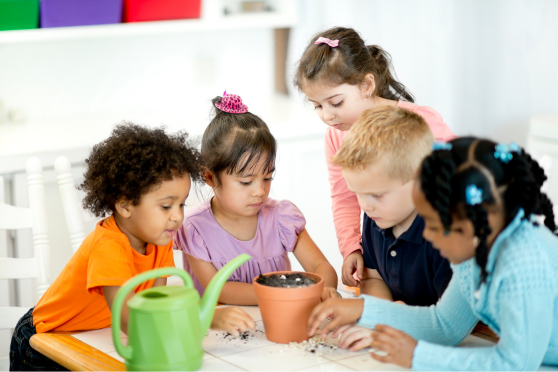
25 Preschool STEM Activities For Early Childhood Teachers: Inquiry-Based Learning
STEM learning starts early in life. The moment children begin to physically interact with their environment, they begin...
ALI Staff | Published February 27, 2024
Teaching science in early childhood exposes young learners to more than foundational concepts in STEM.
It sets the stage for learning well beyond those early years and taps into students’ curiosities and interests about the world around them.
It’s also essential to brain development in early childhood as students learn higher-level language and thinking skills through inquiry-based learning.
Early childhood is the ideal time to introduce children to science, as it helps them find answers to those natural wonderings.
Let’s take a closer look at the power of introducing young learners to scientific thinking and how to make it happen in your classroom, even if you don’t have a science background.
What does science look like in early childhood education?

Science in early childhood education can take on a few different forms, but it’s typically more than a science article for kids.
It’s about includes hands-on exploration, observation, and experimentation.
Play-based learning is also a powerful tool in preschool science that taps into students’ innate curiosity and problem-solving skills.
Learning through play makes science concepts more accessible and engaging for children who are already exploring the world that way.
The benefits of teaching science in early childhood start with engagement.
Science concepts for preschoolers are meant to stimulate curiosity and get students asking about the world around them.
It may even answer questions or wonderings they already had.
Let’s look at a few more.
How students approach science looks different in a preschool science area vs. a middle school classroom, but that doesn’t make it any less meaningful.
Exposing children to STEM concepts early on can still support critical thinking skills, which are so important in future grades.
Through inquiry-based learning, children get introduced to brainstorming, testing simple hypotheses, and experimenting with solutions.
It encourages the kind of thinking that supports higher-level critical thinking down the line and rewards asking questions.
It feels good to conduct experiments that come up with a definitive answer, especially when it’s a question students already have.
Even when the answer isn’t cut and dry, learning how to make discoveries instills confidence in children’s abilities to explore and investigate.
The scientific process for kids is a great way to get children talking. They can discuss their observations, ask questions, and describe what they see, hear, touch, and more.
This develops a higher-level vocabulary and basic communication skills.
Working on hands-on projects as a classroom or in small groups encourages collaboration and cooperation, two key aspects of social-emotional learning.
It helps students see the value in teamwork, sharing ideas, and making discoveries together.
Early exposure to science sets students up for success in kindergarten and later grades. Skills students learn to connect to science are helpful in accessing other content areas, too, including literacy and math.
Teaching science in early childhood can touch every aspect of early childhood brain development.
It can foster a lifelong love for learning. While it may sound intimidating, you’re likely exploring some of these concepts already by the very nature of hands-on learning.
When it comes to science activities for early childhood, keep it simple.
Consider questions already asked by students that you can connect to science concepts and basic experimentation. Use familiar tools around the classroom to create opportunities for play-based learning.
Examples of early childhood science activities include sink or float experiments, bubble towers, and nature walks.
Any activity that ask students to measure, observe, make predictions, or classify objects start with science. Model how to use all five senses to answer questions.
Make use of resources already out there.
Kide Science, a library of story-based lesson plans for children ages 3-8, is an easy way to get started. Read-alouds and imaginary play scenarios are likely already an important part of your classroom.
These activities complement that with a cast of colorful characters that lead students on a journey of scientific exploration.
You don’t need to be a scientist to challenge young learners, embrace experimentation, and connect students to the world around them in a deeper way.
Want to learn more? This podcast with Aino Kuronen, co-founder of Kide Science and a former educator, is a great listen on the impact of story-based learning in connecting kids to the curriculum.
Here are a few key takeaways:
It’s important to teach preschoolers science because it introduces skills like critical thinking, problem-solving, and explaining their thinking. It sets them up for kindergarten and beyond. Perhaps most importantly, it’s fun and engaging.
Children are more likely to connect to content when it meets them at their level, and introducing children to science using play-based learning or storytelling techniques is a great way to do that.

STEM learning starts early in life. The moment children begin to physically interact with their environment, they begin...

The news headlines are daunting. Math scores are down. School districts are scrambling to turn things around. And...

Math assessment in California is changing. What used to be a compliance exercise or reporting tool is now becoming a...